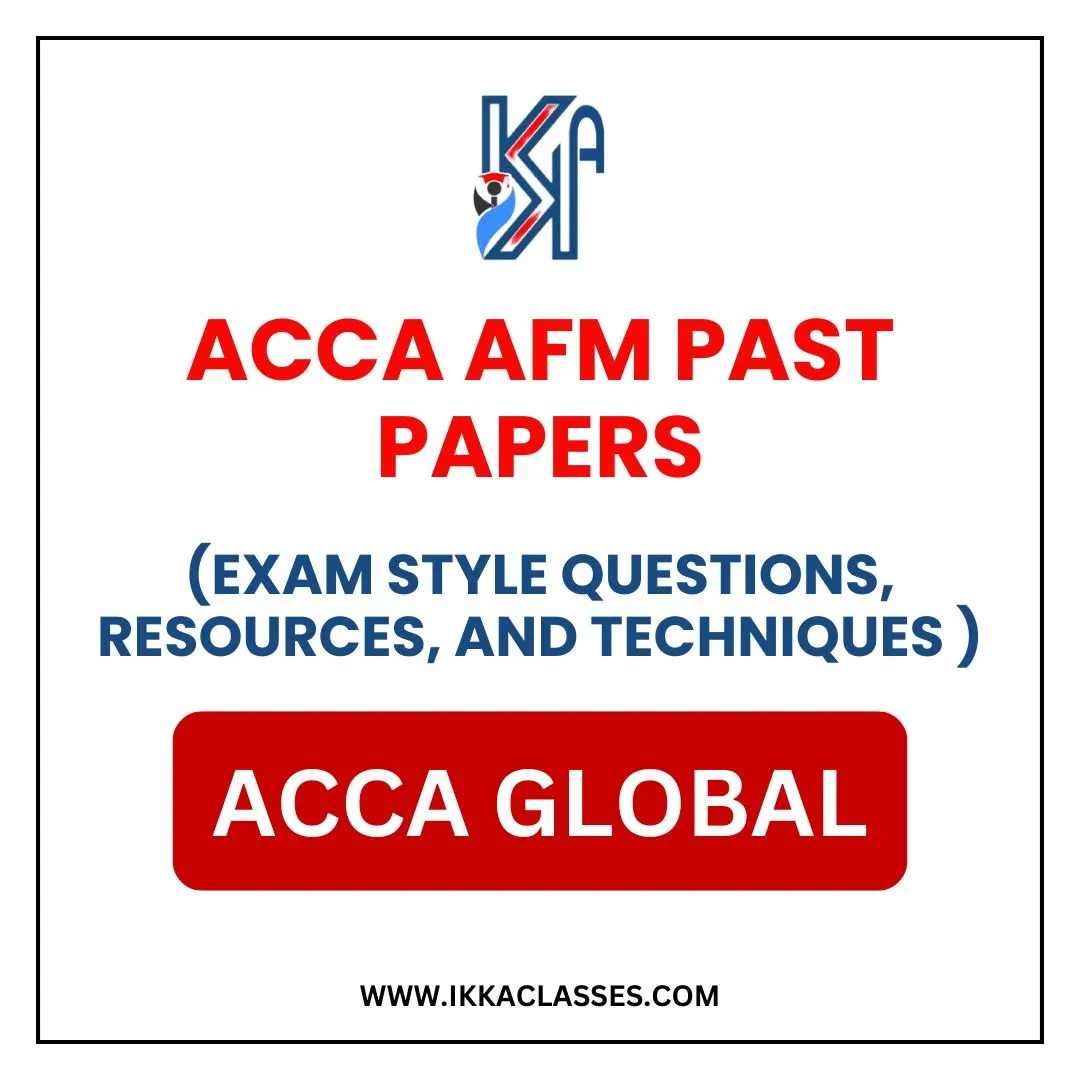You’re staring at your AFM exam in three months. But would you be part of the 45% who pass or the 55% who don’t?
AFM is one of the hardest ACCA papers. It isn’t just about knowing formulas; it’s about applying them under time pressure, handling tricky scenarios, and showing the professional skills examiners look for.
That’s why relying on textbooks alone won’t cut it. You must master the subject, and for that, the finishing touch starts with practicing ACCA AFM past papers.
Most students who fail AFM usually had access to past papers… they just didn’t know how to use them properly.
If you are tired of hunting for random PDFs, outdated notes, or free mock links, and, of course, want to strategically use past papers to pass AFM exams, then stick around.
Table of Contents
ToggleACCA AFM Past Papers
ACCA AFM past papers are real exam questions from previous sitting sessions. These papers show you the exact style of questions you’ll face, the common themes that keep returning, and how much weight is placed on written discussion compared to number crunching.
The paper style goes like this: a meaty 50-mark case study in Section A, plus two 25-mark scenario questions in Section B.
Working through them helps you practice under real exam pressure: spotting tricky wording, planning answers quickly, and avoiding the small mistakes that cost marks. Over time, you start to see the patterns that separate average attempts from scripts that actually pass.

Looking for the actual papers? We’ve got you covered. Below you’ll find a complete list of ACCA AFM past exam papers (including acca past papers afm and acca p4 past papers AFM) with links to examiner reports and answers. Use this as your one-stop reference guide when planning practice sessions.
What Is Included In AFM Specimen Exam Papers?
Specimen papers are different from past papers. They aren’t taken from real exam sittings but are designed by ACCA whenever the syllabus changes or the exam format is updated.
Here’s why they matter:
- They show you how new topics may be tested.
- They reflect the computer-based exam environment, helping you practise typing answers, using spreadsheets, and navigating the interface.
- They act as a trial run, especially if you’re new to Strategic Professional exams.
Think of ACCA P4 past papers AFM as your history guide, while specimen exams are the preview of what’s coming next. Using both together ensures you’re not just solving old problems but also adapting to new exam styles.
How Difficult Is The ACCA AFM Exam Compared To Other Papers?
Strategic Professional exams like AFM, SBL, and AAA are designed to push you beyond rote learning and into real-world application. Among them, AFM consistently ranks as one of the tougher options.
Here’s a snapshot of how AFM compares with its peers (latest ACCA exam sittings):
Exam Paper | Mar 2025 | Jun 2025 | Dec2024 |
SBL | 53% | 51% | 51% |
SBR | 50% | 49% | 51% |
AFM | 45% | 46% | 45% |
AAA | 39% | 40% | 39% |
So, the numbers don’t lie. AFM consistently hovers around 44-46% pass rates, making it one of the toughest ACCA exams after AAA.
But why is AFM so tough? Here are the reasons:
- Professional skills count heavily. Around 20% of your marks come not from formula accuracy, but communication, commercial awareness, and structured presentation.
- Time pressure bites hard. Multiple calculations, discussions, and professional skills – all within 3 3-hour paper is tough.
- Exam nerves hit harder here. One minor calculation mistake can rattle confidence mid-paper. Yet, thanks to the Own Figure Rule, clear logic still earns points despite tiny errors.
- Common Student Stumbling Blocks. Most failures happen because students underestimate the jump from Skills to Strategic level, skip professional skills practice, or rely too heavily on memorization instead of understanding.
Struggling to clear AFM in 1st attempt?
Sometimes a bit of structured guidance can make all the difference. Explore online coaching options that specialize in addressing AFM’s unique challenges.
How Can You Pass The ACCA AFM Exam Successfully?
Let’s be honest – AFM can feel overwhelming. The syllabus is massive, the questions are unpredictable, and the pass rates remind you that this is not a walk in the park. However, with the right approach, you can certainly succeed.
Here’s your roadmap:
- Start With ACCA AFM Past Papers (Your Best Friend)
Work through at least 3-4 years of ACCA AFM past exam papers. But here’s the key: don’t just solve them, dissect them.
Notice how questions are structured. See what topics keep popping up. AFM loves certain themes – you’ll spot the patterns quickly.
Track which topics appear most often. Investment appraisal, risk management, and hedging instruments come back again and again.
If you treat past papers like a mirror, they will show you exactly where you are strong and where you are slipping. - Read every question carefully before jumping in
AFM has a reputation for trick wording. It’s not uncommon for students to lose marks because they rush into answering.
For example, a question might ask: “List the disadvantages of the proposed hedging method,” while students write the advantages. Or it might say “Which of the following is NOT correct?”
Your brain can go into autopilot if you are NOT careful. So, take that extra 10 seconds. Take a pause, underline the keywords, and make sure you understand what is being asked. Trust me, it saves minutes later.

- Time Management is Everything
The AFM exam gives you three hours and 15 minutes for 100 marks. That means roughly 1.9 minutes per mark. If you don’t practice ACCA AFM sample papers under timed conditions, you will never know if a question is dragging you down or how many questions you couldn’t attempt on time.
Always use a stopwatch during practice. It trains your brain to pace itself just like running intervals before a marathon. - Structure Your Answers Like a Pro
Examiners scan answers quickly. So, make their job easy and structure your answers nicely. Use clear sub-headings. Break up your responses with short paragraphs and white space to give paper checkers a breather. - Build a Habit of Continuous Review
Cramming a week before AFM is like trying to run a marathon after jogging once or twice. Instead, schedule smaller, regular sessions. For example:- Mondays: work through one question from past papers.
- Wednesdays: revise technical articles published by ACCA (they often inspire exam questions).
- Fridays: quick revision of formulas like WACC, NPV, and hedging strategies.
- Stay Present During the Exam
Here’s something most guides miss: emotional management. If you mess up one question, don’t carry that frustration forward. Reset between questions. Take a deep breath. Focus only on what’s in front of you now. This way, you are constantly reinforcing concepts rather than trying to relearn the syllabus at the last minute.
What Additional Resources Should You Consider When Using AFM Past Papers?
While we have covered the core strategies for tackling AFM, your preparation toolkit shouldn’t stop at AFM ACCA past papers alone.
Here are some additional resources that complement past paper practice:
- Watch Debrief Videos & Webinars
After working through past papers, hunt down examiner debrief videos on ACCA Global. These are gold mines. Examiners literally tell you what went wrong in previous sittings – common mistakes, missed opportunities, better approaches.
When it comes to webinars, Many ACCA-approved providers run live sessions and podcasts, breaking down tricky topics. Join them, even if you think you know the material. Fresh perspectives often unlock new understanding. - Examiner’s Reports
Now these are different from debrief videos. Examiner’s reports are written summaries that explain why candidates passed or failed, along with examiner commentary on their exam technique.

- Practice Mock Exams
Once you get comfortable with ACCA AFM past papers, you must try solving mock test papers. Many learning providers like Ikka Classes offer mock exams with marking services, so you get feedback almost like a dress rehearsal for the big day. - Technical Article Deep Dives
Beyond the casual reading we mentioned earlier, some technical articles deserve serious study time. Look for articles that expand on complex topics you’ve struggled with in past papers. They often provide a broader context that makes complex concepts easier to understand. - Computer-Based Environment Practice
Here’s something many students overlook: AFM is computer-based, but most people practice on paper. The interface matters.Use ACCA’s practice platform or mock exam software to get comfortable typing answers, using spreadsheets, and navigating between questions.
Small adjustments, like knowing the shortcuts or how to structure an answer digitally, can save minutes when it counts.
- Stay Alert to Syllabus Updates
AFM evolves constantly. New standards, updated regulations, fresh case studies.Check ACCA’s website quarterly for syllabus changes. What worked for last year’s papers may not be applicable to this year’s focus areas. Subscribe to their updates or set calendar reminders.
Frequently Asked Questions About ACCA AFM Past Papers
How Difficult Is AFM ACCA?
AFM is considered one of ACCA’s most challenging papers, with pass rates typically ranging from 40% to 45%. The difficulty comes from its complex calculations, tight time limits, and the need to think like a real finance manager under pressure.
How Long Is The AFM Exam?
The ACCA AFM exam is 3 hours and 15 minutes long. The exam is computer-based, with its structure divided into a 50-mark scenario-based case study and two 25-mark questions.

